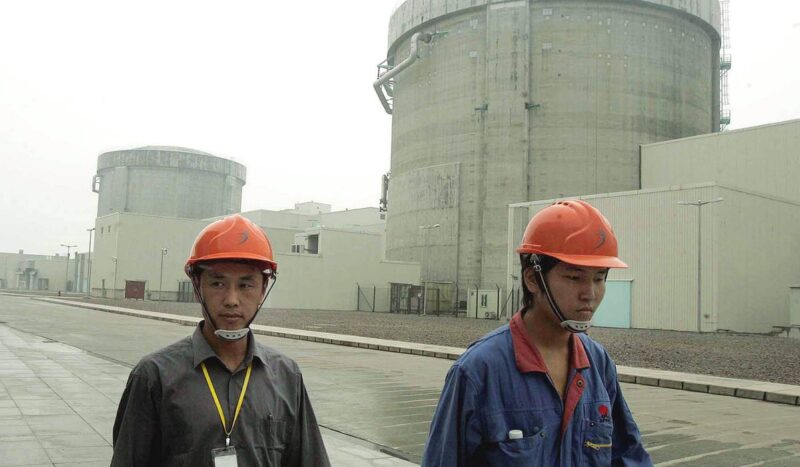America is closing older nuclear energy vegetation and solely taking child steps towards constructing new ones whereas China, the world’s No. 2 financial system, aggressively ramps up its nuclear energy stock so as to add 37 new reactors prior to now decade.
Just one new nuclear energy plant has opened within the U.S. prior to now 30 years due to issues about security and prices.
At its present tempo, China‘s capability to generate electrical energy from nuclear energy vegetation is on monitor to overhaul France in 2025 and shall be on par with the U.S. in 2030.
“China‘s nuclear rise is pushed by demand,” Francois Morin, China director on the World Nuclear Affiliation, informed The Washington Occasions.
Like China, America is going through rising vitality wants. However moderately than ramping up fossil fuels and nuclear energy, the U.S. is taking steps to cut back extra dependable vitality sources and change them with intermittent renewables resembling wind and photo voltaic.
Twelve U.S. nuclear energy reactors have been completely shuttered since 2012, decreasing the fleet to 93 working business nuclear reactors.
Plant Vogtle in Waynesboro, Georgia, which turned totally operational in July, was the primary new nuclear energy plant to open within the U.S. prior to now 30 years.
Nuclear vitality, the most important supply of unpolluted U.S. energy since 1984, peaked at 20% of the U.S. electrical energy grid in 2020 and has began to say no, dropping to beneath 19% final yr.
Nuclear energy is forecast to make up solely 12% of the U.S. vitality grid by 2050, the Vitality Info Administration stated, whereas photo voltaic and wind will enhance steadily to 18% by subsequent yr.
Nuclear energy has grow to be a shrinking a part of the U.S. vitality combine as President Biden has moved to finish using all fossil fuels, together with pure fuel, within the nation’s electrical grid.
“I’m not essentially involved that China is constructing nuclear, I’m extra involved that the US is totally taking an axe to its personal skill to supply inexpensive, ample, dependable vitality,” Jack Spencer, senior analysis fellow for vitality and environmental coverage for the conservative Heritage Basis, stated.
The shift away from dependable vitality sources has put the U.S. grid in danger this winter, the North American Electrical Reliability Company warned final month.
“The expansion of intermittent assets, like photo voltaic technology, on the distribution system considerably will increase load forecasting complexity and uncertainty,” Mark Olson, NERC’s supervisor of reliability assessments, stated.
China is shifting in the wrong way, constructing each coal and nuclear energy vegetation to satisfy the nation’s rising vitality wants.
Whereas U.S. new nuclear energy vegetation are a rarity, China has grow to be largely self-sufficient in developing nuclear reactors whereas additionally adapting to and bettering upon Western expertise, Mr. Morin stated.
China plans to start exporting its nuclear expertise, together with heavy parts, into the worldwide provide chain.
China now operates 55 nuclear reactors and is constructing an extra 26 reactors. It has not shuttered a single nuclear energy plant.
It has additionally surged manufacturing of recent coal-fired energy vegetation and has permitted extra new coal vegetation within the third quarter of this yr than all of 2021, in line with Greenpeace. About 63% of China‘s vitality is derived from coal.
Nuclear vitality makes up about 5% of electrical energy technology in China. Factoring within the nation’s rising vitality demand and ramped-up manufacturing of nuclear reactors, it’s anticipated to extend to 18% by 2050.
China considers nuclear energy a inexperienced vitality supply. Nuclear reactors use nuclear fission to warmth water and produce steam that generates electrical energy with out emitting carbon dioxide or pollution.
Together with wind and photo voltaic, which made up 14% of China‘s vitality grid in 2022, nuclear energy is a part of the nation’s plan to cut back reliance on fossil fuels and finally reduce on polluting coal vegetation whereas rising vitality safety.
“They didn’t look ahead to vitality shortage or provide threat to advertise nuclear vitality,” Mr. Morin stated.
The Biden administration is incorporating nuclear energy into its plan to remove fossil fuels from the vitality grid and has spent $6 billion to maintain getting older nuclear energy vegetation in operation. Nevertheless, it has grow to be almost inconceivable to win federal approval for brand spanking new nuclear energy plant initiatives, which might take greater than a decade to finish at a value of billions of {dollars}.
Building of the Vogtle challenge, which incorporates 4 reactors, started in 2009, endured repeated delays and value roughly $30 billion, greater than double the unique estimate.
The challenge was slowed by the cumbersome allowing course of, the nation’s lack of a nuclear vitality provide chain and an absence of expert employees. All of it needed to be reestablished to construct the plant.
Vogtle’s fourth reactor is anticipated to start operations by early 2024 and when accomplished, the plant would be the largest generator of unpolluted vitality in the whole nation.
It is perhaps the final new U.S. nuclear energy plant for some time.
Plans for the brand new expertise of small-scale nuclear energy vegetation have but to succeed.
Oregon-based NuScale Energy final month canceled plans to make use of new expertise to construct a 6-reactor plant in Idaho, citing development price issues. The plant was supposed to switch space coal vegetation and supply sufficient electrical energy for 300,000 houses by 2029.
Regardless of hurdles, the U.S. is pledging to resuscitate its flagging nuclear energy sector.
Nuclear’s future within the U.S. was bolstered final week on the United Nation’s COP28 local weather change convention. The U.S. joined 21 different international locations in a pledge to triple nuclear vitality capability by 2050, which the Worldwide Vitality Company believes is essential to decreasing carbon emissions.
It’s no assure China, which didn’t signal the pledge, gained’t overtake the US.
“If the U.S. apply to themselves such a dedication, then in 2050 China and U.S. nuclear energy capacities ought to nonetheless be comparable,” Mr. Morin stated. “If such a advice applies for the world as a complete, however the U.S. solely doubles their present capability, then China shall be far forward. Certainly, although China didn’t signal the declaration, the Chinese language plan is to quintuple its present working capability by 2050.”








